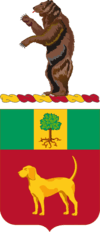203rd Engineer Battalion (United States)
The 203rd Engineer Battalion is a combat engineer battalion of the Missouri Army National Guard.
| 203rd Engineer Battalion | |
|---|---|
 Coat of arms | |
| Active | 1921 |
| Country | |
| Branch | Missouri Army National Guard |
| Type | Combat engineer |
| Size | Regiment |
| Motto(s) | "Don't Kick Our Dog" |
| March | Ya Gotta Quit Kickin My Dog Aroun |
| Commanders | |
| Commander | LTC Michael Seek |
| Insignia | |
| Distinctive unit insignia (left) |  |
The 203rd Engineer Combat Battalion can trace its history back to Missouri volunteer militia units that formed in 1883, when the militia units in southwest Missouri were reorganized into the 2nd Infantry Regiment of the National Guard of Missouri in 1890 and mustered into federal service during the Spanish–American War.[1] The 2nd Missouri Infantry was called up to serve during the Mexican border dispute in 1916; redesigned as 128th, 129th, and 130th machine gun battalions in 1917; transformed into the 203rd Artillery, Coast Artillery Corps in 1921; inducted into federal service in September 1940; and was later sent to Alaska for the Aleutian Campaign.
History/lineage
Constituted in the Missouri National Guard 28 April 1921 as 2nd Artillery (AA) from new and existing units as follows-
- HHB from
- 1st Battalion HHB from new
- A Battery from B Company 128th Machine Gun Battalion
- B Battery from B Company 129th Machine Gun Battalion
- C Battery from new
- D Battery from B Company 140th Infantry Regiment
- 2nd Battalion HHB from new
- E Battery from new
- F Battery from B Company 130th Machine Gun Battalion
- G Battery from A Company 130th Machine Gun Battalion
Reorganized 19 April 1924 as 203rd Coast Artillery (AA)
Inducted into Federal service 16 September 1940
- 3rd Battalion Constituted 27 May 1942 at Fort McDowell, California
Regiment broken up 12 February 1944 as follows-
- HHB as 203rd Antiaircraft Artillery Group (eventually redesignated HHD 35th Division Trains)
- 1st Battalion as 86th Antiaircraft Artillery Gun Battalion
- 2nd Battalion as 592nd Antiaircraft Artillery Automatic Weapons Battalion
- 3rd Battalion as 299th Antiaircraft Searchlight Battalion
Units redesignated in 1946 as Follows-
- 86th Battalion as 108th Mechanized Cavalry Reconnaissance Squadron (27 June 1946)
- 592nd Battalion as 196th Tank Battalion (27 June 1946)
- 299th Battalion as 175th Military Police (3 July 1946)
108th Mechanized Cavalry Reconnaissance Squadron redesignated 1 November 1949 as 203rd Antiaircraft Artillery Automatic Weapons Battalion (mobile), reorganized and redesignated 1 December 1952 as 203rd Antiaircraft Artillery Gun Battalion. redesignated 1 October 1953 as 203rd Antiaircraft Artillery Battalion (90mm).
- consolidated 15 April 1959 with 203rd Combat Arms Regiment, a parent regiment under the Combat Arms Regimental System. This was part of the larger reorganization that placed the Army National Guard under the ROCID/Pentomic organization. The battalion was redesignated 1st Reconnaissance Squadron, 203rd Combat Arms Regiment, and had its units remain in place at Joplin, Anderson, Monett, and Neosho.[2]
- redesignated 203rd Armor Regiment 1963
- redesignated 203rd Engineer Battalion 1968
Distinctive unit insignia
- Description
A houn’ dawg statant Proper on a gold ribbon scroll bearing the motto "DON’T KICK OUR DOG" in red. The insignia is made in pairs.
- Symbolism
The 203d Coast Artillery Regiment was known as "The Houn’ Dawg Regiment."
- Background
The distinctive unit insignia was originally approved for the 203d Coast Artillery Regiment on 12 January 1925. It was amended to have the insignia manufactured in pairs on 18 December 1926. The insignia was redesignated for the 203d Antiaircraft Artillery Automatic Weapons Battalion on 10 October 1950. It was redesignated for the 203d Armor Regiment on 26 October 1961. It was authorized for the 203d Engineer Battalion on 14 January 1969.
Coat of arms
- Blazon
- Shield: Gules, a houn’ dawg statant Or, on a chief Vert a pale of the second (Or) charged with an oak tree eradicated Proper.
- Crest: That for the regiments and separate battalions of the Missouri Army National Guard: On a wreath of the colors Or and Gules, a grizzly bear standing rampant Proper.
- Motto: "Don't Kick Our Dog".
- Symbolism
- Shield: The shield is red for Artillery, charged with the indispensable companion of the Regiment, the Regiment having been for years known as "The Houn’ Dawg Regiment." The green chief represents the Mexican Border service, the yellow pale the Spanish War service and the oak tree the Argonne Forest, the Meuse-Argonne of World War
- Crest: The crest is that of the Missouri Army National Guard.
- Background: The coat of arms was originally approved for the 203d Coast Artillery Regiment on 13 January 1925. It was redesignated for the 203d Antiaircraft Artillery Automatic Weapons Battalion on 6 October 1950. The insignia was redesignated for the 203d Armor Regiment on 26 October 1961. It was authorized for the 203d Engineer Battalion on 14 January 1969.
Current Force Structure
The current makeup of the 203rd Engineer Battalion is a Combat Heavy Engineer Battalion made up around 800 soldiers. The current force structure includes one vertical construction company the 276th Engineer Company based in Pierce City MO. The 1141st Engineer Company(Sapper) based in Kansas City MO. The 1135th Engineer Company (Route Clearance) based in Richmond MO. The 294th horizontal Engineer Company based out of Carthage MO. The HHC and FSC Company is based out of Joplin MO
See also
- Coats of arms of U.S. Engineer Battalions
References
